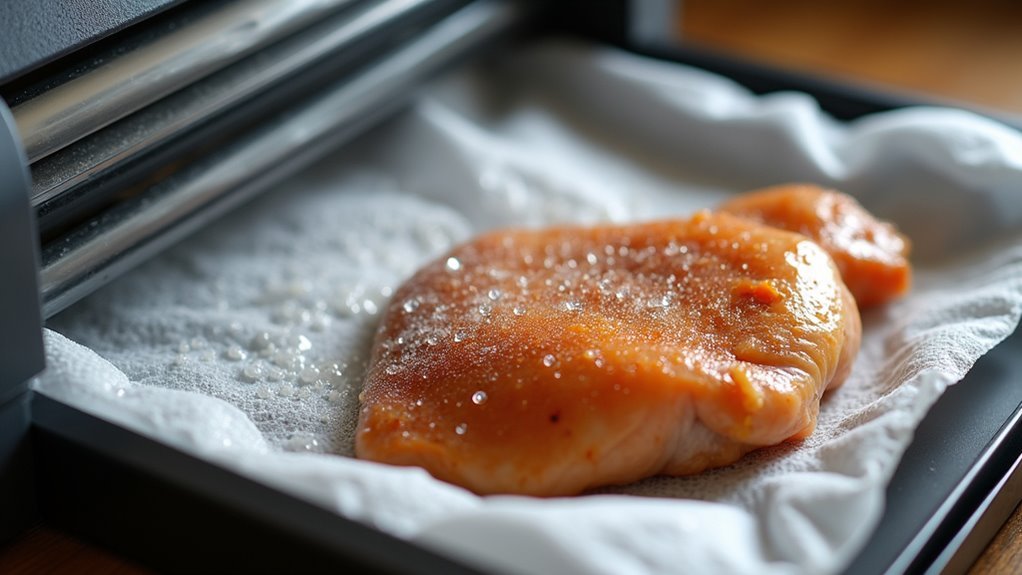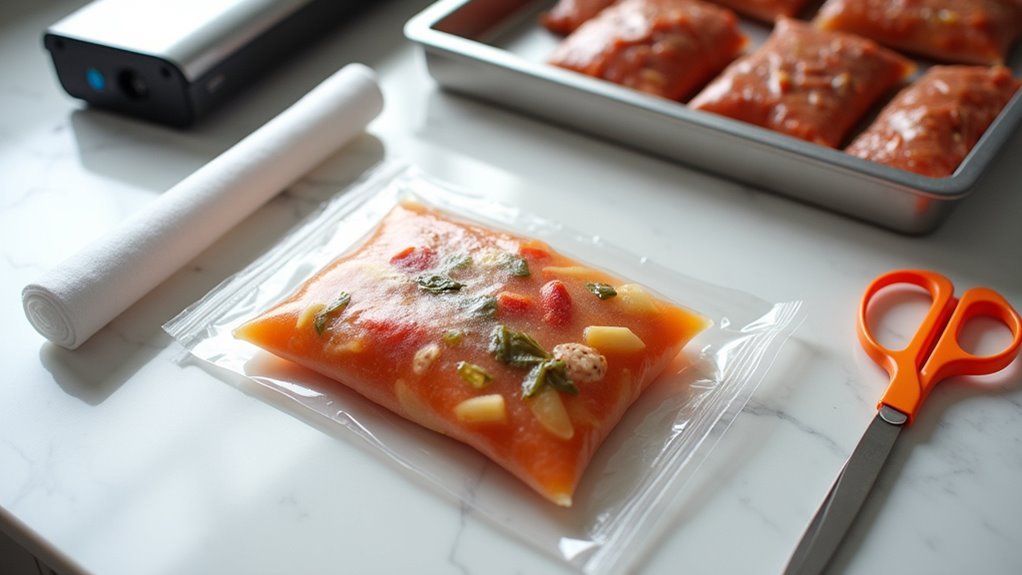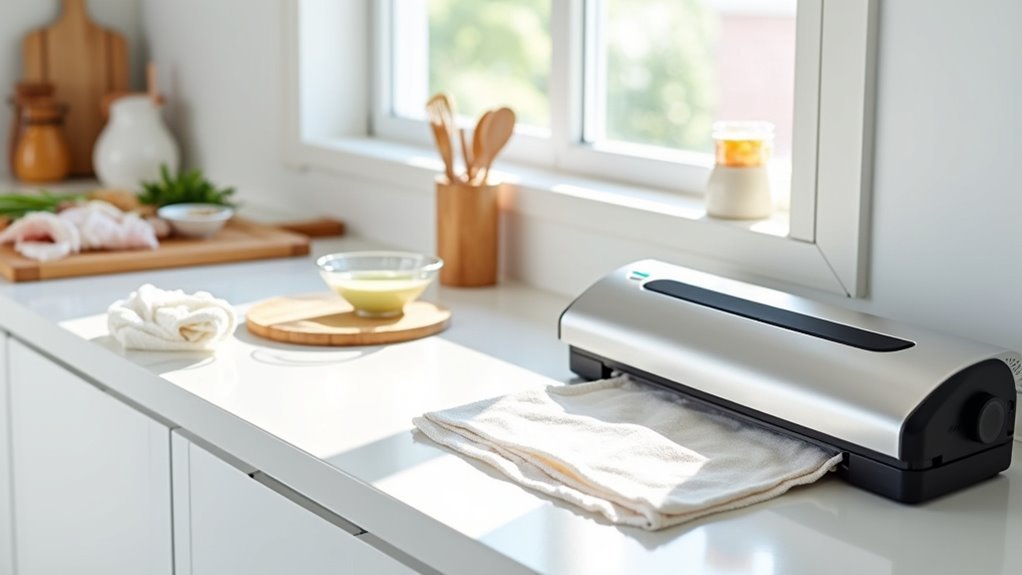We’ve discovered that the secret to vacuum sealing wet food lies in controlling moisture before it reaches your sealer. Pre-freezing liquids until solid eliminates messy spills, while paper towels inside bags absorb excess moisture during sealing. Always wipe the sealing area completely dry and use longer bags for better monitoring. Manual operation gives you control to stop when moisture approaches the sealing strip. These proven techniques will transform your frustrating sealing experiences into successful preservation sessions.
Why Wet Food Ruins Vacuum Sealing and How to Prevent It

When we’re excited to preserve our favorite soups, stews, or marinated meats, wet food can quickly turn our vacuum sealing dreams into a frustrating mess.
The problem starts when moisture creeps toward the sealing area of our vacuum bags, preventing that essential airtight seal we need for proper preservation. Without this tight closure, air sneaks back in, causing freezer burn and spoilage that defeats our entire purpose.
Even worse, excess liquid can get sucked into our vacuum sealer’s motor, potentially damaging the machine.
To prevent these headaches, we’ll want to blot the edges of our bags completely dry before sealing. Using paper towels around the sealing area removes any lingering moisture that could sabotage our efforts and keeps our food perfectly preserved. Additionally, ensuring food freshness is maintained effectively is vital for maximizing the benefits of vacuum sealing.
Essential Tools and Equipment for Sealing Liquids Successfully
Success in vacuum sealing liquids depends heavily on having the right tools at our fingertips, and we’re about to discover the game-changing equipment that’ll transform our wet food preservation efforts.
First, let’s grab a canning funnel – this simple tool prevents spills when pouring liquids into bags, making our vacuum sealing process much cleaner.
We’ll also want specialty liquid vacuum bags, which feature thicker materials that won’t leak during sealing.
Paper towels become our secret weapon for absorbing excess moisture inside bags, ensuring they seal properly without interference.
Don’t forget regular maintenance of our vacuum sealer itself – clean sealing strips guarantee reliable performance.
Additionally, using specialized vacuum sealers can help effectively manage liquid sealing without compromising the quality of the food.
When we combine these essential tools, we’ll Vacuum Seal Liquids like pros, achieving perfect food storage results every time.
The Pre-Freezing Method: Your Best Strategy for Mess-Free Sealing

Although vacuum sealing wet foods might seem tricky at first, we’ve discovered that pre-freezing is absolutely the smartest approach for achieving mess-free results every single time.
When you freeze liquids overnight, they transform into solid blocks that won’t get sucked into your vacuum sealer, protecting both your machine and vacuum bag from unwanted spills.
This method works brilliantly for meal prep since you can easily portion everything beforehand.
Here’s why pre-freezing changes everything:
- Creates frozen blocks that seal cleanly without liquid interference
- Eliminates messy spills during the vacuum sealing process
- Maintains food integrity while ensuring proper airtight seals
- Reduces spoilage risk and prevents freezer burn effectively
- Vacuum sealing extends shelf life by inhibiting bacterial growth without oxygen.
You’ll love how this technique makes vacuum sealing completely hassle-free!
Manual Vacuum Techniques for Better Moisture Control
While pre-freezing works wonderfully, we’ve found that mastering manual vacuum techniques gives you incredible control over moisture during the sealing process. Instead of letting your machine run automatically, manually operate the vacuum function and watch carefully for liquid movement. The moment you see moisture approaching the sealing strip, stop the vacuum and immediately seal the bag. This prevents liquid from contaminating the seal area and ruining your bags.
We also recommend using longer vacuum bags, which give you more room to monitor and control the process. Place a paper towel inside the bag to absorb excess moisture, ensuring a clean seal every time. Using these methods can enhance your food preservation while minimizing the risk of freezer burn, which is particularly beneficial for meat and poultry.
These manual vacuum techniques dramatically reduce food waste while giving you professional results at home.
Smart Preparation Tips to Keep Your Sealing Area Clean

Beyond mastering the vacuum process itself, keeping your workspace organized and clean makes all the difference between frustrating failures and perfectly sealed packages.
We’ve learned that preparation prevents those annoying moments when liquid creeps into the sealing area and ruins our vacuum sealers’ performance.
Smart preparation starts before we even turn on our machines:
- Pre-freeze liquids until solid to eliminate spills during the sealing process
- Use a canning funnel to pour liquids into bags without creating mess around the edges
- Place a paper towel inside the bag to absorb excess liquid from moist foods
- Leave adequate space at the bag’s top to prevent overfilling and liquid overflow
Always wipe the sealing area completely dry before sealing—moisture there guarantees seal failure. Additionally, using chamber vacuum machines can effectively seal wet foods without compromising quality.
Troubleshooting Common Wet Food Sealing Problems
Even when we follow every preparation step perfectly, wet food vacuum sealing can still throw us some curveballs that leave us scratching our heads. Let’s tackle the most common hiccups and their solutions.
| Problem | Cause | Solution |
|---|---|---|
| Liquid overflow into machine | Excess moisture during vacuum | Use manual vacuum function for better control |
| Poor seal quality | Wet seal area | Wipe seal area completely dry before sealing |
| Bag melting from grease | High fat content | Reverse bag edges or use grease-resistant bags |
| Liquid contamination | Free-flowing liquids | Try freezing liquid portions first, then vacuum seal |
The manual vacuum function becomes our best friend when dealing with tricky wet foods, giving us precise control over the process and preventing those frustrating liquid mishaps. Additionally, it’s important to ensure that all vacuum seal bags are labeled microwave-safe to avoid potential hazards during reheating.
Frequently Asked Questions
What Is the Best Way to Vacuum Seal Wet Food?
We’ll pre-freeze wet food until solid for the best vacuum sealers. Our tips for sealing include using paper towels to absorb moisture and proper food storage techniques for avoiding spills.
How to Vacuum Seal With Liquid in the Bag?
We’ll use liquid retention methods like pre-freezing and paper towels inside the best vacuum bags. These food preservation techniques and sealing tips prevent spills while ensuring proper vacuum sealing without damaging your machine.
How to Vacuum Wet Food?
We’ll pre-freeze wet foods first, then use proper vacuum sealing techniques with quality bag material options. Following food safety tips and maintaining your vacuum sealer guarantees successful sealing without ruining bags.
How to Prevent Liquid From Going Into a Vacuum Sealer?
We’ll prevent liquid from entering your vacuum sealer by using liquid barriers like paper towels, employing freezing techniques beforehand, choosing longer bag selection, and utilizing manual sealing methods for better control.
